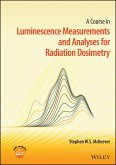David S. Sholl (Georgia Institute of Technology, Atlanta, GA), Janice A. Steckel (National Ene United States Department of Energy
Density Functional Theory
A Practical Introduction
David S. Sholl (Georgia Institute of Technology, Atlanta, GA), Janice A. Steckel (National Ene United States Department of Energy
Density Functional Theory
A Practical Introduction
- Gebundenes Buch
- Merkliste
- Auf die Merkliste
- Bewerten Bewerten
- Teilen
- Produkt teilen
- Produkterinnerung
- Produkterinnerung
Eine prägnante, gut strukturierte Einführung in die Anwendungen von DFT-Berechnungen
In der neu überarbeiteten zweiten Auflage von Density Functional Theory: A Practical Introduction liefern die Autoren eine prägnante und leicht verständliche Einführung in die wichtigsten Konzepte und praktischen Anwendungen der Dichtefunktionaltheorie (DFT), wobei der Schwerpunkt auf die DFT der ebenen Wellen gelegt wird. Die Autoren, die über jahrzehntelange Erfahrung auf diesem Gebiet verfügen, bieten Studierenden mit unterschiedlichen Vorkenntnissen ein ausgewogenes Maß an Verständlichkeit und Klarheit…mehr
Andere Kunden interessierten sich auch für
![A Course in Luminescence Measurements and Analyses for Radiation Dosimetry A Course in Luminescence Measurements and Analyses for Radiation Dosimetry]() Stephen W. S. McKeever (Oklahoma State University)A Course in Luminescence Measurements and Analyses for Radiation Dosimetry114,99 €
Stephen W. S. McKeever (Oklahoma State University)A Course in Luminescence Measurements and Analyses for Radiation Dosimetry114,99 €![Physics of Matter Physics of Matter]() George C. King (UK University of Manchester)Physics of Matter60,99 €
George C. King (UK University of Manchester)Physics of Matter60,99 €![Kittel's Introduction to Solid State Physics, Global Edition Kittel's Introduction to Solid State Physics, Global Edition]() Charles Kittel (Berkeley University of California)Kittel's Introduction to Solid State Physics, Global Edition64,99 €
Charles Kittel (Berkeley University of California)Kittel's Introduction to Solid State Physics, Global Edition64,99 €![Chemometrics and Numerical Methods in Libs Chemometrics and Numerical Methods in Libs]() Chemometrics and Numerical Methods in Libs153,99 €
Chemometrics and Numerical Methods in Libs153,99 €![Introduction to Computational Chemistry Introduction to Computational Chemistry]() Frank Jensen (Denmark Odense University)Introduction to Computational Chemistry86,99 €
Frank Jensen (Denmark Odense University)Introduction to Computational Chemistry86,99 €![Atomistic Simulations of Glasses Atomistic Simulations of Glasses]() Jincheng DuAtomistic Simulations of Glasses203,99 €
Jincheng DuAtomistic Simulations of Glasses203,99 €![Wide Bandgap Nanowires Wide Bandgap Nanowires]() Tuan Anh Pham (Griffith University, Queensland, Australia)Wide Bandgap Nanowires178,99 €
Tuan Anh Pham (Griffith University, Queensland, Australia)Wide Bandgap Nanowires178,99 €-
-
-
Eine prägnante, gut strukturierte Einführung in die Anwendungen von DFT-Berechnungen
In der neu überarbeiteten zweiten Auflage von Density Functional Theory: A Practical Introduction liefern die Autoren eine prägnante und leicht verständliche Einführung in die wichtigsten Konzepte und praktischen Anwendungen der Dichtefunktionaltheorie (DFT), wobei der Schwerpunkt auf die DFT der ebenen Wellen gelegt wird. Die Autoren, die über jahrzehntelange Erfahrung auf diesem Gebiet verfügen, bieten Studierenden mit unterschiedlichen Vorkenntnissen ein ausgewogenes Maß an Verständlichkeit und Klarheit und haben auf diese Weise ein insgesamt sehr gut zu verstehendes Fachbuch verfasst.
_ In dieser neuen Auflage werden die Genauigkeit von DFT-Berechnungen und die Wahl der Funktionale detailliert erörtert
_ Das Werk bietet einen Überblick über ein breites Spektrum an verfügbaren DFT-Codes
_ Mit zusätzlichen Beispielen zur Nutzung von DFT für Berechnungen von Materialien mit hohem Durchsatz
_ Stärkere Hervorhebung der Berechnung von Phasendiagrammen und offener Ensemble-Methoden, die in der Elektrochemie umfassend genutzt werden.
_ In dieser erweiterten Auflage werden auch Berechnungen abgedeckt, die über die Standard-DFT hinausgehen, z. B. DFT mit Dispersionskorrektur, DFT+U und zeitabhängige DFT
Hinweis: Dieser Artikel kann nur an eine deutsche Lieferadresse ausgeliefert werden.
In der neu überarbeiteten zweiten Auflage von Density Functional Theory: A Practical Introduction liefern die Autoren eine prägnante und leicht verständliche Einführung in die wichtigsten Konzepte und praktischen Anwendungen der Dichtefunktionaltheorie (DFT), wobei der Schwerpunkt auf die DFT der ebenen Wellen gelegt wird. Die Autoren, die über jahrzehntelange Erfahrung auf diesem Gebiet verfügen, bieten Studierenden mit unterschiedlichen Vorkenntnissen ein ausgewogenes Maß an Verständlichkeit und Klarheit und haben auf diese Weise ein insgesamt sehr gut zu verstehendes Fachbuch verfasst.
_ In dieser neuen Auflage werden die Genauigkeit von DFT-Berechnungen und die Wahl der Funktionale detailliert erörtert
_ Das Werk bietet einen Überblick über ein breites Spektrum an verfügbaren DFT-Codes
_ Mit zusätzlichen Beispielen zur Nutzung von DFT für Berechnungen von Materialien mit hohem Durchsatz
_ Stärkere Hervorhebung der Berechnung von Phasendiagrammen und offener Ensemble-Methoden, die in der Elektrochemie umfassend genutzt werden.
_ In dieser erweiterten Auflage werden auch Berechnungen abgedeckt, die über die Standard-DFT hinausgehen, z. B. DFT mit Dispersionskorrektur, DFT+U und zeitabhängige DFT
Hinweis: Dieser Artikel kann nur an eine deutsche Lieferadresse ausgeliefert werden.
Produktdetails
- Produktdetails
- Verlag: Wiley / Wiley & Sons
- Artikelnr. des Verlages: 1W119840860
- 2. Aufl.
- Seitenzahl: 224
- Erscheinungstermin: 19. Dezember 2022
- Englisch
- Abmessung: 258mm x 181mm x 19mm
- Gewicht: 523g
- ISBN-13: 9781119840862
- ISBN-10: 1119840864
- Artikelnr.: 66269984
- Herstellerkennzeichnung
- Libri GmbH
- Europaallee 1
- 36244 Bad Hersfeld
- gpsr@libri.de
- Verlag: Wiley / Wiley & Sons
- Artikelnr. des Verlages: 1W119840860
- 2. Aufl.
- Seitenzahl: 224
- Erscheinungstermin: 19. Dezember 2022
- Englisch
- Abmessung: 258mm x 181mm x 19mm
- Gewicht: 523g
- ISBN-13: 9781119840862
- ISBN-10: 1119840864
- Artikelnr.: 66269984
- Herstellerkennzeichnung
- Libri GmbH
- Europaallee 1
- 36244 Bad Hersfeld
- gpsr@libri.de
David S. Sholl leads the Transformational Decarbonization Initiative at the Oak Ridge National Laboratory and is a Professor of Chemical & Biomolecular Engineering at the Georgia Institute of Technology. Janice A. Steckel is a Physical Scientist at the United States Department of Energy, National Energy Technology Laboratory in Pittsburgh, Pennsylvania.
1 What Is Density Functional Theory?
1.1 How to Approach This Book
1.2 Examples of DFT in Action
1.2.1 Ammonia Synthesis by Heterogeneous Catalysis
1.2.2 Embrittlement of Metals by Trace Impurities
1.2.3 Materials Properties for Modeling Planetary Formation
1.2.4 High Throughput/Big Data Case Study
1.3 The Schrödinger Equation
1.4 Density Functional Theory-From Wave Functions to Electron Density
1.5 Exchange- Correlation Functional
1.6 The Quantum Chemistry Tourist
1.6.1 Localized and Spatially Extended Functions
1.6.2 Wave-Function-Based Methods
1.6.3 Hartree- Fock Method
1.6.4 Beyond Hartree-Fock
1.7 What Can DFT Not Do?
1.8 Which DFT Code Should I Use?
1.9 Density Functional Theory in Other Fields
1.10 How to Approach This Book
2 DFT Calculations for Simple Solids
2.1 Periodic Structures, Supercells, and Lattice Parameters
2.2 Face-Centered Cubic Materials
2.3 Hexagonal Close-Packed Materials
2.4 Crystal Structure Prediction
2.5 Phase Transformations
Exercises
3 Nuts and Bolts of DFT Calculations
3.1 Reciprocal Space and k Points
3.1.1 Plane Waves and the Brillouin Zone
3.1.2 Integrals in k Space
3.1.3 Choosing k Points in the Brillouin Zone
3.1.4 Metals-Special Cases in k Space; DFT+U
3.1.5 Summary of k Space
3.2 Energy Cutoffs
3.2.1 Pseudopotentials
3.3 Numerical Optimization
3.3.1 Optimization in One Dimension
3.3.2 Optimization in More than One Dimension
3.3.3 What Do I Really Need to Know about Optimization?
3.4 DFT Total Energies-An Iterative Optimization Problem
3.5 Geometry Optimization
3.5.1 Internal Degrees of Freedom
3.5.2 Geometry Optimization with Constrained Atoms
3.5.3 Optimizing Supercell Volume and Shape
Appendix: Calculation Details
4 Thinking About Accuracy and Choosing Functionals for DFT Calculations
4.1 How Accurate Are DFT Calculations?
4.2 Choosing a Functional
4.3 Examples of Physical Accuracy
4.3.1 Benchmark Calculations for Molecular Systems-Energy and Geometry
4.3.2 Benchmark Calculations for Molecular Systems-Vibrational Frequencies
4.3.3 Crystal Structures and Cohesive Energies
4.3.4 Adsorption Energies and Bond Strengths
4.4 How to Use the Rest of this Book
5 DFT Calculations for Surfaces of Solids and Interfaces in Crystals
5.1 Importance of Surfaces
5.2 Periodic Boundary Conditions and Slab Models
5.3 Choosing k Points for Surface Calculations
5.4 Classification of Surfaces by Miller Indices
5.5 Surface Relaxation
5.6 Calculation of Surface Energies
5.7 Symmetric and Asymmetric Slab Models
5.8 Surface Reconstruction
5.9 Adsorbates on Surfaces
5.9.1 Accuracy of Adsorption Energies
5.10 Effects of Surface Coverage
5.11 Grain Boundaries in Solids
Exercises
Appendix: Calculation Details
6 DFT Calculations of Vibrational Frequencies
6.1 Isolated Molecules
6.2 Vibrations of a Collection of Atoms
6.3 Molecules on Surfaces
6.4 Zero-Point Energies
6.5 Phonons and Delocalized Modes
Exercises
7 Calculating Rates of Chemical Processes Using Transition State Theory
7.1 One-Dimensional Example
7.2 Multidimensional Transition State Theory
7.3 Finding Transition States
7.3.1 Elastic Band Method
7.3.2 Nudged Elastic Band Method and the Dimer Method
7.3.3 Initializing NEB Calculations
7.4 Finding the Right Transition States
7.5 Connecting Individual Rates to Overall Dynamics
7.6 Quantum Effects and Other Complications
7.6.1 High Temperatures/Low Barriers
7.6.2 Quantum Tunneling
7.6.3 Zero-Point Energies
Exercises
Appendix: Calculation Details
8 Equilibrium Phase Diagrams and Electrochemistry with Open Ensemble
Methods
8.1 Stability of Bulk Metal Oxides
8.1.1 Examples Including Disorder-Configurational Entropy
8.2 Stability of Metal and Metal Oxide Surfaces
8.3 Multiple Chemical Potentials and Coupled Chemical Reactions
8.4 DFT for Electrochemistry
Exercises
Appendix: Calculation Details
9 Electronic Structure and Magnetic Properties
9.1 Electronic Density of States
9.2 Local Density of States and Atomic Charges
9.3 Magnetism
Exercises
10 Ab Initio Molecular Dynamics
10.1 Classical Molecular Dynamics
10.1.1 Molecular Dynamics with Constant Energy
10.1.2 Molecular Dynamics in the Canonical Ensemble
10.1.3 Practical Aspects of Classical Molecular Dynamics
10.2 Ab Initio Molecular Dynamics: Gaussian Basis Sets in Non-Plane Wave
Codes
10.3 Applications of Ab Initio Molecular Dynamics
10.3.1 Exploring Structurally Complex Materials: Liquids and Amorphous
Phases
10.3.2 Exploring Complex Energy Surfaces
10.4 Time-Dependent Density Functional Theory
Exercises
Appendix: Calculation Details
11 Methods beyond "Standard" Calculations
11.1 Choosing a Functional (Revisited)
11.2 Estimating Uncertainties in DFT Results Using the BEEF Approach
11.3 DFT+X Methods for Improved Treatment of Electron Correlation
11.3.1 Dispersion Interactions and DFT-D and D2, D3, TS methods
11.4 Self-Interaction Error, Strongly Correlated Electron Systems, and
DFT+U
11.5 RPA
11.6 Larger System Sizes with Linear Scaling Methods and Classical Force
Fields
11.7 Conclusion
1.1 How to Approach This Book
1.2 Examples of DFT in Action
1.2.1 Ammonia Synthesis by Heterogeneous Catalysis
1.2.2 Embrittlement of Metals by Trace Impurities
1.2.3 Materials Properties for Modeling Planetary Formation
1.2.4 High Throughput/Big Data Case Study
1.3 The Schrödinger Equation
1.4 Density Functional Theory-From Wave Functions to Electron Density
1.5 Exchange- Correlation Functional
1.6 The Quantum Chemistry Tourist
1.6.1 Localized and Spatially Extended Functions
1.6.2 Wave-Function-Based Methods
1.6.3 Hartree- Fock Method
1.6.4 Beyond Hartree-Fock
1.7 What Can DFT Not Do?
1.8 Which DFT Code Should I Use?
1.9 Density Functional Theory in Other Fields
1.10 How to Approach This Book
2 DFT Calculations for Simple Solids
2.1 Periodic Structures, Supercells, and Lattice Parameters
2.2 Face-Centered Cubic Materials
2.3 Hexagonal Close-Packed Materials
2.4 Crystal Structure Prediction
2.5 Phase Transformations
Exercises
3 Nuts and Bolts of DFT Calculations
3.1 Reciprocal Space and k Points
3.1.1 Plane Waves and the Brillouin Zone
3.1.2 Integrals in k Space
3.1.3 Choosing k Points in the Brillouin Zone
3.1.4 Metals-Special Cases in k Space; DFT+U
3.1.5 Summary of k Space
3.2 Energy Cutoffs
3.2.1 Pseudopotentials
3.3 Numerical Optimization
3.3.1 Optimization in One Dimension
3.3.2 Optimization in More than One Dimension
3.3.3 What Do I Really Need to Know about Optimization?
3.4 DFT Total Energies-An Iterative Optimization Problem
3.5 Geometry Optimization
3.5.1 Internal Degrees of Freedom
3.5.2 Geometry Optimization with Constrained Atoms
3.5.3 Optimizing Supercell Volume and Shape
Appendix: Calculation Details
4 Thinking About Accuracy and Choosing Functionals for DFT Calculations
4.1 How Accurate Are DFT Calculations?
4.2 Choosing a Functional
4.3 Examples of Physical Accuracy
4.3.1 Benchmark Calculations for Molecular Systems-Energy and Geometry
4.3.2 Benchmark Calculations for Molecular Systems-Vibrational Frequencies
4.3.3 Crystal Structures and Cohesive Energies
4.3.4 Adsorption Energies and Bond Strengths
4.4 How to Use the Rest of this Book
5 DFT Calculations for Surfaces of Solids and Interfaces in Crystals
5.1 Importance of Surfaces
5.2 Periodic Boundary Conditions and Slab Models
5.3 Choosing k Points for Surface Calculations
5.4 Classification of Surfaces by Miller Indices
5.5 Surface Relaxation
5.6 Calculation of Surface Energies
5.7 Symmetric and Asymmetric Slab Models
5.8 Surface Reconstruction
5.9 Adsorbates on Surfaces
5.9.1 Accuracy of Adsorption Energies
5.10 Effects of Surface Coverage
5.11 Grain Boundaries in Solids
Exercises
Appendix: Calculation Details
6 DFT Calculations of Vibrational Frequencies
6.1 Isolated Molecules
6.2 Vibrations of a Collection of Atoms
6.3 Molecules on Surfaces
6.4 Zero-Point Energies
6.5 Phonons and Delocalized Modes
Exercises
7 Calculating Rates of Chemical Processes Using Transition State Theory
7.1 One-Dimensional Example
7.2 Multidimensional Transition State Theory
7.3 Finding Transition States
7.3.1 Elastic Band Method
7.3.2 Nudged Elastic Band Method and the Dimer Method
7.3.3 Initializing NEB Calculations
7.4 Finding the Right Transition States
7.5 Connecting Individual Rates to Overall Dynamics
7.6 Quantum Effects and Other Complications
7.6.1 High Temperatures/Low Barriers
7.6.2 Quantum Tunneling
7.6.3 Zero-Point Energies
Exercises
Appendix: Calculation Details
8 Equilibrium Phase Diagrams and Electrochemistry with Open Ensemble
Methods
8.1 Stability of Bulk Metal Oxides
8.1.1 Examples Including Disorder-Configurational Entropy
8.2 Stability of Metal and Metal Oxide Surfaces
8.3 Multiple Chemical Potentials and Coupled Chemical Reactions
8.4 DFT for Electrochemistry
Exercises
Appendix: Calculation Details
9 Electronic Structure and Magnetic Properties
9.1 Electronic Density of States
9.2 Local Density of States and Atomic Charges
9.3 Magnetism
Exercises
10 Ab Initio Molecular Dynamics
10.1 Classical Molecular Dynamics
10.1.1 Molecular Dynamics with Constant Energy
10.1.2 Molecular Dynamics in the Canonical Ensemble
10.1.3 Practical Aspects of Classical Molecular Dynamics
10.2 Ab Initio Molecular Dynamics: Gaussian Basis Sets in Non-Plane Wave
Codes
10.3 Applications of Ab Initio Molecular Dynamics
10.3.1 Exploring Structurally Complex Materials: Liquids and Amorphous
Phases
10.3.2 Exploring Complex Energy Surfaces
10.4 Time-Dependent Density Functional Theory
Exercises
Appendix: Calculation Details
11 Methods beyond "Standard" Calculations
11.1 Choosing a Functional (Revisited)
11.2 Estimating Uncertainties in DFT Results Using the BEEF Approach
11.3 DFT+X Methods for Improved Treatment of Electron Correlation
11.3.1 Dispersion Interactions and DFT-D and D2, D3, TS methods
11.4 Self-Interaction Error, Strongly Correlated Electron Systems, and
DFT+U
11.5 RPA
11.6 Larger System Sizes with Linear Scaling Methods and Classical Force
Fields
11.7 Conclusion
1 What Is Density Functional Theory?
1.1 How to Approach This Book
1.2 Examples of DFT in Action
1.2.1 Ammonia Synthesis by Heterogeneous Catalysis
1.2.2 Embrittlement of Metals by Trace Impurities
1.2.3 Materials Properties for Modeling Planetary Formation
1.2.4 High Throughput/Big Data Case Study
1.3 The Schrödinger Equation
1.4 Density Functional Theory-From Wave Functions to Electron Density
1.5 Exchange- Correlation Functional
1.6 The Quantum Chemistry Tourist
1.6.1 Localized and Spatially Extended Functions
1.6.2 Wave-Function-Based Methods
1.6.3 Hartree- Fock Method
1.6.4 Beyond Hartree-Fock
1.7 What Can DFT Not Do?
1.8 Which DFT Code Should I Use?
1.9 Density Functional Theory in Other Fields
1.10 How to Approach This Book
2 DFT Calculations for Simple Solids
2.1 Periodic Structures, Supercells, and Lattice Parameters
2.2 Face-Centered Cubic Materials
2.3 Hexagonal Close-Packed Materials
2.4 Crystal Structure Prediction
2.5 Phase Transformations
Exercises
3 Nuts and Bolts of DFT Calculations
3.1 Reciprocal Space and k Points
3.1.1 Plane Waves and the Brillouin Zone
3.1.2 Integrals in k Space
3.1.3 Choosing k Points in the Brillouin Zone
3.1.4 Metals-Special Cases in k Space; DFT+U
3.1.5 Summary of k Space
3.2 Energy Cutoffs
3.2.1 Pseudopotentials
3.3 Numerical Optimization
3.3.1 Optimization in One Dimension
3.3.2 Optimization in More than One Dimension
3.3.3 What Do I Really Need to Know about Optimization?
3.4 DFT Total Energies-An Iterative Optimization Problem
3.5 Geometry Optimization
3.5.1 Internal Degrees of Freedom
3.5.2 Geometry Optimization with Constrained Atoms
3.5.3 Optimizing Supercell Volume and Shape
Appendix: Calculation Details
4 Thinking About Accuracy and Choosing Functionals for DFT Calculations
4.1 How Accurate Are DFT Calculations?
4.2 Choosing a Functional
4.3 Examples of Physical Accuracy
4.3.1 Benchmark Calculations for Molecular Systems-Energy and Geometry
4.3.2 Benchmark Calculations for Molecular Systems-Vibrational Frequencies
4.3.3 Crystal Structures and Cohesive Energies
4.3.4 Adsorption Energies and Bond Strengths
4.4 How to Use the Rest of this Book
5 DFT Calculations for Surfaces of Solids and Interfaces in Crystals
5.1 Importance of Surfaces
5.2 Periodic Boundary Conditions and Slab Models
5.3 Choosing k Points for Surface Calculations
5.4 Classification of Surfaces by Miller Indices
5.5 Surface Relaxation
5.6 Calculation of Surface Energies
5.7 Symmetric and Asymmetric Slab Models
5.8 Surface Reconstruction
5.9 Adsorbates on Surfaces
5.9.1 Accuracy of Adsorption Energies
5.10 Effects of Surface Coverage
5.11 Grain Boundaries in Solids
Exercises
Appendix: Calculation Details
6 DFT Calculations of Vibrational Frequencies
6.1 Isolated Molecules
6.2 Vibrations of a Collection of Atoms
6.3 Molecules on Surfaces
6.4 Zero-Point Energies
6.5 Phonons and Delocalized Modes
Exercises
7 Calculating Rates of Chemical Processes Using Transition State Theory
7.1 One-Dimensional Example
7.2 Multidimensional Transition State Theory
7.3 Finding Transition States
7.3.1 Elastic Band Method
7.3.2 Nudged Elastic Band Method and the Dimer Method
7.3.3 Initializing NEB Calculations
7.4 Finding the Right Transition States
7.5 Connecting Individual Rates to Overall Dynamics
7.6 Quantum Effects and Other Complications
7.6.1 High Temperatures/Low Barriers
7.6.2 Quantum Tunneling
7.6.3 Zero-Point Energies
Exercises
Appendix: Calculation Details
8 Equilibrium Phase Diagrams and Electrochemistry with Open Ensemble
Methods
8.1 Stability of Bulk Metal Oxides
8.1.1 Examples Including Disorder-Configurational Entropy
8.2 Stability of Metal and Metal Oxide Surfaces
8.3 Multiple Chemical Potentials and Coupled Chemical Reactions
8.4 DFT for Electrochemistry
Exercises
Appendix: Calculation Details
9 Electronic Structure and Magnetic Properties
9.1 Electronic Density of States
9.2 Local Density of States and Atomic Charges
9.3 Magnetism
Exercises
10 Ab Initio Molecular Dynamics
10.1 Classical Molecular Dynamics
10.1.1 Molecular Dynamics with Constant Energy
10.1.2 Molecular Dynamics in the Canonical Ensemble
10.1.3 Practical Aspects of Classical Molecular Dynamics
10.2 Ab Initio Molecular Dynamics: Gaussian Basis Sets in Non-Plane Wave
Codes
10.3 Applications of Ab Initio Molecular Dynamics
10.3.1 Exploring Structurally Complex Materials: Liquids and Amorphous
Phases
10.3.2 Exploring Complex Energy Surfaces
10.4 Time-Dependent Density Functional Theory
Exercises
Appendix: Calculation Details
11 Methods beyond "Standard" Calculations
11.1 Choosing a Functional (Revisited)
11.2 Estimating Uncertainties in DFT Results Using the BEEF Approach
11.3 DFT+X Methods for Improved Treatment of Electron Correlation
11.3.1 Dispersion Interactions and DFT-D and D2, D3, TS methods
11.4 Self-Interaction Error, Strongly Correlated Electron Systems, and
DFT+U
11.5 RPA
11.6 Larger System Sizes with Linear Scaling Methods and Classical Force
Fields
11.7 Conclusion
1.1 How to Approach This Book
1.2 Examples of DFT in Action
1.2.1 Ammonia Synthesis by Heterogeneous Catalysis
1.2.2 Embrittlement of Metals by Trace Impurities
1.2.3 Materials Properties for Modeling Planetary Formation
1.2.4 High Throughput/Big Data Case Study
1.3 The Schrödinger Equation
1.4 Density Functional Theory-From Wave Functions to Electron Density
1.5 Exchange- Correlation Functional
1.6 The Quantum Chemistry Tourist
1.6.1 Localized and Spatially Extended Functions
1.6.2 Wave-Function-Based Methods
1.6.3 Hartree- Fock Method
1.6.4 Beyond Hartree-Fock
1.7 What Can DFT Not Do?
1.8 Which DFT Code Should I Use?
1.9 Density Functional Theory in Other Fields
1.10 How to Approach This Book
2 DFT Calculations for Simple Solids
2.1 Periodic Structures, Supercells, and Lattice Parameters
2.2 Face-Centered Cubic Materials
2.3 Hexagonal Close-Packed Materials
2.4 Crystal Structure Prediction
2.5 Phase Transformations
Exercises
3 Nuts and Bolts of DFT Calculations
3.1 Reciprocal Space and k Points
3.1.1 Plane Waves and the Brillouin Zone
3.1.2 Integrals in k Space
3.1.3 Choosing k Points in the Brillouin Zone
3.1.4 Metals-Special Cases in k Space; DFT+U
3.1.5 Summary of k Space
3.2 Energy Cutoffs
3.2.1 Pseudopotentials
3.3 Numerical Optimization
3.3.1 Optimization in One Dimension
3.3.2 Optimization in More than One Dimension
3.3.3 What Do I Really Need to Know about Optimization?
3.4 DFT Total Energies-An Iterative Optimization Problem
3.5 Geometry Optimization
3.5.1 Internal Degrees of Freedom
3.5.2 Geometry Optimization with Constrained Atoms
3.5.3 Optimizing Supercell Volume and Shape
Appendix: Calculation Details
4 Thinking About Accuracy and Choosing Functionals for DFT Calculations
4.1 How Accurate Are DFT Calculations?
4.2 Choosing a Functional
4.3 Examples of Physical Accuracy
4.3.1 Benchmark Calculations for Molecular Systems-Energy and Geometry
4.3.2 Benchmark Calculations for Molecular Systems-Vibrational Frequencies
4.3.3 Crystal Structures and Cohesive Energies
4.3.4 Adsorption Energies and Bond Strengths
4.4 How to Use the Rest of this Book
5 DFT Calculations for Surfaces of Solids and Interfaces in Crystals
5.1 Importance of Surfaces
5.2 Periodic Boundary Conditions and Slab Models
5.3 Choosing k Points for Surface Calculations
5.4 Classification of Surfaces by Miller Indices
5.5 Surface Relaxation
5.6 Calculation of Surface Energies
5.7 Symmetric and Asymmetric Slab Models
5.8 Surface Reconstruction
5.9 Adsorbates on Surfaces
5.9.1 Accuracy of Adsorption Energies
5.10 Effects of Surface Coverage
5.11 Grain Boundaries in Solids
Exercises
Appendix: Calculation Details
6 DFT Calculations of Vibrational Frequencies
6.1 Isolated Molecules
6.2 Vibrations of a Collection of Atoms
6.3 Molecules on Surfaces
6.4 Zero-Point Energies
6.5 Phonons and Delocalized Modes
Exercises
7 Calculating Rates of Chemical Processes Using Transition State Theory
7.1 One-Dimensional Example
7.2 Multidimensional Transition State Theory
7.3 Finding Transition States
7.3.1 Elastic Band Method
7.3.2 Nudged Elastic Band Method and the Dimer Method
7.3.3 Initializing NEB Calculations
7.4 Finding the Right Transition States
7.5 Connecting Individual Rates to Overall Dynamics
7.6 Quantum Effects and Other Complications
7.6.1 High Temperatures/Low Barriers
7.6.2 Quantum Tunneling
7.6.3 Zero-Point Energies
Exercises
Appendix: Calculation Details
8 Equilibrium Phase Diagrams and Electrochemistry with Open Ensemble
Methods
8.1 Stability of Bulk Metal Oxides
8.1.1 Examples Including Disorder-Configurational Entropy
8.2 Stability of Metal and Metal Oxide Surfaces
8.3 Multiple Chemical Potentials and Coupled Chemical Reactions
8.4 DFT for Electrochemistry
Exercises
Appendix: Calculation Details
9 Electronic Structure and Magnetic Properties
9.1 Electronic Density of States
9.2 Local Density of States and Atomic Charges
9.3 Magnetism
Exercises
10 Ab Initio Molecular Dynamics
10.1 Classical Molecular Dynamics
10.1.1 Molecular Dynamics with Constant Energy
10.1.2 Molecular Dynamics in the Canonical Ensemble
10.1.3 Practical Aspects of Classical Molecular Dynamics
10.2 Ab Initio Molecular Dynamics: Gaussian Basis Sets in Non-Plane Wave
Codes
10.3 Applications of Ab Initio Molecular Dynamics
10.3.1 Exploring Structurally Complex Materials: Liquids and Amorphous
Phases
10.3.2 Exploring Complex Energy Surfaces
10.4 Time-Dependent Density Functional Theory
Exercises
Appendix: Calculation Details
11 Methods beyond "Standard" Calculations
11.1 Choosing a Functional (Revisited)
11.2 Estimating Uncertainties in DFT Results Using the BEEF Approach
11.3 DFT+X Methods for Improved Treatment of Electron Correlation
11.3.1 Dispersion Interactions and DFT-D and D2, D3, TS methods
11.4 Self-Interaction Error, Strongly Correlated Electron Systems, and
DFT+U
11.5 RPA
11.6 Larger System Sizes with Linear Scaling Methods and Classical Force
Fields
11.7 Conclusion








